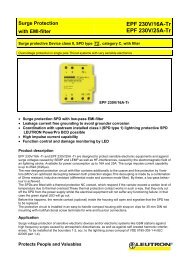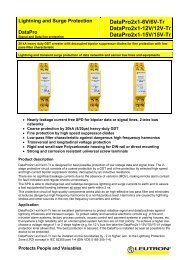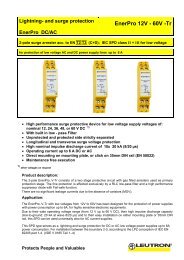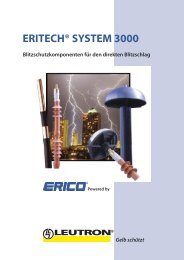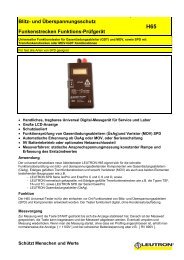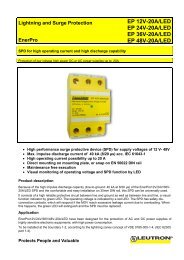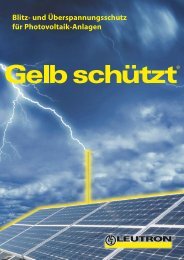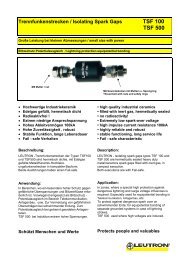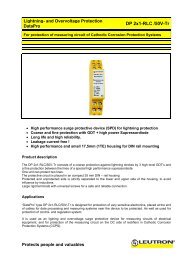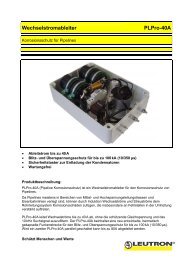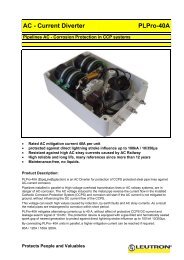Part - Leutron GmbH
Part - Leutron GmbH
Part - Leutron GmbH
Create successful ePaper yourself
Turn your PDF publications into a flip-book with our unique Google optimized e-Paper software.
Technological Details<br />
Technical Terms<br />
Protection Path<br />
The parts of an SPD can be connected as “conductor against conductor”<br />
or “neutral conductor against earth”, or a combination of<br />
these possibilities. These methods of connection are called protection<br />
paths.<br />
Pulse<br />
A pulse is a rapid, temporary change of a physical parameter<br />
followed by a fast change back to the original value.<br />
Rate of Rise<br />
The rate of rise is the average change rate of a parameter between<br />
two certain values, e.g. between 10 % and 90 % of the peak value.<br />
Rated Voltage of an Arrester U c<br />
Maximum acceptable root-mean-square value of the power-frequency<br />
ac voltage that can be permanently applied to the terminals<br />
of the arrester.<br />
Reference Earth<br />
Reference earth is the reference ground (especially the earth’s surface)<br />
that is so far apart from the earthing electrodes that, if a current<br />
is diverted into the ground, no relevant voltage differences occur between<br />
the points of this area.<br />
Remote Signalling Contact<br />
Remote signalling contacts belong to a circuit which is separated<br />
from the main circuit of the SPD. The disconnection device of the<br />
SPD and/or an operation indication are part of the same circuit.<br />
Remote Strikes<br />
Remote strikes cause surges with a considerable smaller energy content<br />
compared to close-up strikes.<br />
Residual Current Protective Device (RCD)<br />
Residual current protective devices disconnect the circuit if the residual<br />
current against earth exceeds a certain value.<br />
Residual Voltage Ures<br />
The residual voltage is the peak value of the voltage that appears between<br />
the terminals of an SPD during the flow of a discharge current<br />
or immediately after it.<br />
Short-circuit Withstand Capability<br />
The short-circuit withstand capability is the highest unaffected<br />
short-circuit current the surge protection device can withstand.<br />
Single-port SPD<br />
A single-port SPD is connected in parallel to the circuit to be protected.<br />
A single-port SPD may have separate input and output terminals,<br />
although, without any series impedance between them.<br />
Sparkover Voltage<br />
The sparkover voltage is the highest instantaneous value of the voltage<br />
at the terminals of an arrester, just before it is triggered.<br />
Specialist in Lightning Protection<br />
A specialist in lightning protection has a professional training, knowledge<br />
and expertise as well as knowledge of the corresponding regulations<br />
that allow him to assess the work assigned to him as well<br />
as to identify possible dangers. (To judge the professional training,<br />
one can also consider several years of working in the corresponding<br />
field.)<br />
Status Display<br />
The status display indicates the state of operation of an SPD.<br />
Surge Voltage<br />
A surge voltage is a voltage that puts people and/or technical<br />
equipment like conductors and devices at risk. It can permanently<br />
(overvoltage) or temporarily (surge voltage) occur between conductor<br />
and earth in error-free installations (in disconnected conductors<br />
as well).<br />
Surge-voltage Protection Device (SPD)<br />
A surge-voltage protection device limits transient surges and diverts<br />
impulse currents. It includes at least one non-linear component.<br />
Temperature Range<br />
The temperature range describes the lowest and highest temperatures<br />
that are allowed at or inside the housing. For devices without<br />
self-heating this range refers to the ambient temperature. For devices<br />
with self-heating it indicates the maximum operating temperature<br />
range.<br />
TOV Characteristics<br />
The TOV characteristics describe the behavviour of an SPD to which<br />
a temporary overvoltage (TOV) is applied for a certain period of time.<br />
Transient (noun)<br />
A transient is a non-periodic and very short positive or negative<br />
change of voltage or current between two steady states.<br />
transient<br />
A transient behaviour describes the behaviour of a phenomenon or<br />
value which changes between two consecutive steady states in a<br />
very short time in comparison to the considered timescale.<br />
Transverse Voltage<br />
The transverse voltage is the interference voltage which occurs between<br />
two conductors of the same circuit.<br />
Triggering Current of the Disconnection Device<br />
The triggering current of the disconnection device is the root-meansquare<br />
value of the current through the arrester, which causes the<br />
disconnection device to operate within 30 seconds.<br />
10 <strong>Leutron</strong> <strong>GmbH</strong> · Humboldtstrasse 30 · 70771 Leinfelden-Echterdingen · Germany · Phone +49 711 94771-0 · www.leutron.de



